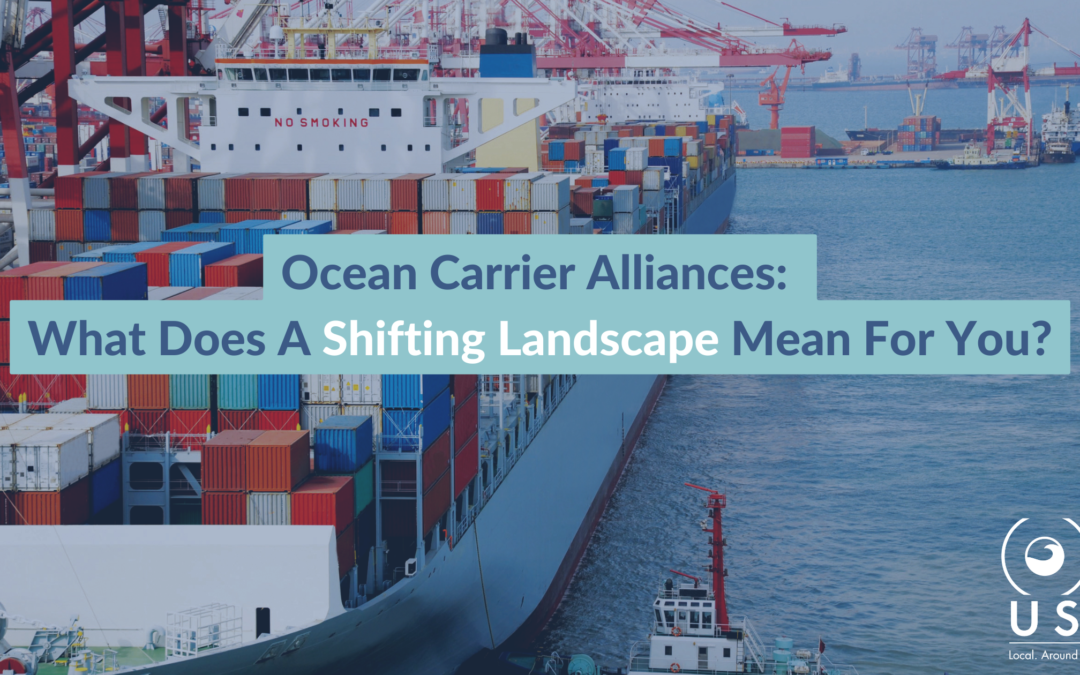
Ocean Carrier Alliances: What Does A Shifting Landscape Mean For You?
There are a number of reasons for some of the significant carriers to team up with one another (instead of directly competing). These alliances allow the carriers to pool cargo between them, and share their resources without trying to outdo the competition on pricing. Over the past decade, several carriers have made similar agreements with one another to take advantage of the opportunities working together affords them. We’ve been through several generations of major shipping alliances by now, and the latest is considered to have really begun in 2017.
This latest generation included three major alliances—2M, Ocean, and THE.
- 2M: Maersk, MSC, and ZIM.
- Ocean: COSCO, OOCL, Evergreen, and CMA
- THE: Hapag-Lloyd, ONE, HMM, and YML.
These types of alliances have come and gone since the nineties, but this latest round is a bit different from ones we’ve seen before. The scale of the combined carriers is much wider than previous arrangements. 2M, for example, represents 30% of the world’s container trading capacity. This type of consolidation plainly has an impact on global shipping—and has, in some cases, raised antitrust concerns. Let’s take a closer look at the carrier alliances, and what the future might look like.
The Biggest Alliance Benefit: Standardization
One of the most obvious reasons for the success of franchises like McDonald’s is an essentially universal experience. Big Macs in Florida are just like Big Macs in Wyoming; it’s always familiar, which is comforting. But shipping practices and available technologies aren’t always identical between carriers.
One of the most significant market-wide benefits of these alliances has been the expansion of digitization practices. Shipping a container with one carrier within an alliance is a much more standardized experience than it used to be. And with much of the shipping field allied with multiple partners, processes are now very nearly identical. This improved interoperability results in a much simpler experience for most customers, which can help make your own processes simpler in turn.
Market Impact
While carriers are enjoying benefits on their end and customers are receiving a more standardized experience, alliances aren’t necessarily helping the shipping market. The International Transport Forum—and inter-governmental organization (operating within the Organization for Economic Cooperation and Devolopment, or OECD) with 65 member countries dedicated to providing policy makers with accurate information and recommendations to improve the global transport system—released a report in 2018 titled The Impact of Alliances in Container Shipping. The report takes a negative view of alliances, indicating that they are not having a positive impact on global trade.
The report indicates that these alliances are causing a number of market conditions that are unfavorable for their customers. Because the shipping industry has become much more tightly concentrated, competition is dramatically reduced. The sheer size of these carriers allows them to dominate shipping volume, creating a market imbalance that squeezes out other, smaller carriers who can’t compete within their individual shipping lanes. The concentration of shipping also leads to less efficient use of public infrastructure, reduced schedule reliability, and longer wait times for shipping.
Shipping customers tend to want simple things: lower costs, reliable service, and speedy deliveries. The mere fact that options are reduced by the lack of competitive options makes those priorities harder to come by on the open market.
Some Alliances are Ending
While this isn’t exactly breaking news, the 2M Alliance is coming to an end. In 2025, when the terms of the alliance expire, they will not be renewed, and the largest carrier alliance will no longer be in effect. We’re facing some interesting changes in the global shipping industry. With 2M dissolved, suddenly the market will have significantly greater competition. It should also be noted that the other two main alliances may eventually follow suit. While there’s no news to report in that regard, it’s possible that they also elect to dissolve their agreements.
Fewer alliances and greater numbers of individual carriers will mean some changes. First, as technology grows in different directions, it’s possible that we’ll start to see diverging experiences from one carrier to another. Since they’re no longer pooling resources, one carrier might invest in new types of digital tracking systems, for example, and offer their customers a more proprietary experience that another carrier can’t. And that’s just one tiny potential facet of what we might see.
Greater market competition will allow individual carriers the opportunity to distinguish themselves from their competitors. Tighter, leaner operations might offer greater reliability, of course, which is always beneficial. But, for many shipping customers, the bottom line is where they focus their attention.
While the end result of dissolving alliances won’t really be known until after they’ve ended, we can make some predictions on a number of aspects of container shipping. And it’s obvious from every market report that price competition is likely to be fiercer in the future. When carriers need to compete with one another, the simplest way to attract greater volume is with competitive pricing, along with better service.
Fewer alliances and increased individual carrier operations will mean shipping customers will have more options than they’ve had in a long time. Pricing, service experience, customer relations, technology—when you have a less standardized experience, customers will find the best shipping partners for their business, something that is harder to do when you only have a few options.
Of course, we strongly recommend working with a third-party logistics provider like OL-USA. As a single-source partner, we can help you find the right carriers for you at the right time—which might be harder to do in a landscape with increased competition. We can help you find and secure the best possible shipping rates with the most reliable carriers—without signing a long-term contract.


